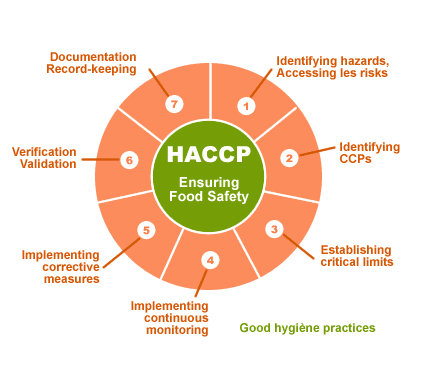Food is
mandatory for life, so it is extremely important that our food supply is
safe. But what if contaminated food
could cause as many as 76 million Americans to get sick every year? Unfortunately, this statistic is true. With products getting recalled and outbreaks
of illness frequently seen in the news, much of America has lost confidence in
the safety of our food supply.
So what can
be done to improve the safety of America’s food? One answer to this question is preventing
outbreaks from occurring. There are
various programs used by companies to assure safety and quality of their products,
including Hazard Analysis and Critical Control Points (HACCP). HACCP programs identify points in production
where significant threats to food safety or quality could occur. Limits are established on these control
points and procedures are put in place to document when the limits are
met. Corrective actions are created in
case a deviation from the limit occurs, and records are kept up to date on
production. These records can then be
inspected by USDA or FDA officials.
Food
processing facilities can also be inspected by the USDA and FDA. Currently, the USDA is required to inspect
meat and poultry facilities more often than the FDA is required to inspect
other plants. Additionally, the FDA does
not inspect the majority of imported food – in fact, less than 1% of imported
food is inspected! With these suppliers
creating their own laws for quality and safety, the United States should be
more critical of imported foods. The
Center for Science in the Public Interest suggests that the FDA should create a
system to certify the safety of imported food.
If this certification was seen on food packaging, consumers could also
feel more at ease purchasing foreign products.
In recent
years, new legislation has been signed into law to improve food safety. The Food Safety Modernization Act (FSMA)
enhanced FDA requirements in outbreak prevention, facility inspection and
compliance, food imports, and other areas.
Food facilities are now required to create preventative control plans
like HACCP. The FDA also had to
establish production standards for food production. There were multiple changes to import
regulations. The FDA now has more
authority in food imports, including the ability to require further
certification of products and deny imports.
While a
consumer like yourself may not be able to create food safety laws, there are
many actions you can take against foodborne illness! One action that may seem obvious is washing
your hands when preparing food, and this is especially important when handling
meat. Also, separate cutting boards
should be used for meat and ready to eat foods to prevent the spread of
bacteria.
Cooking and
storing food at the proper temperature is extremely important! Bacteria that cause foodborne illness thrive
in the temperature range between 40°-140°F.
To prevent illness, refrigerators should be kept a few degrees below
40°F. Food thermometers should be used
to monitor the temperature of meat and poultry while cooking as well.
Foodborne
illness will always remain a concern to our country. However, new legislation has been able to
improve the FDA’s authority in inspecting domestic and international
foods. Requirements for food production
facilities have also been improved to ensure a safer food supply. The FDA and USDA are not the only ones who
can take action against foodborne illness.
If consumers follow some easy tips, they too can prevent foodborne
illness.



No comments:
Post a Comment